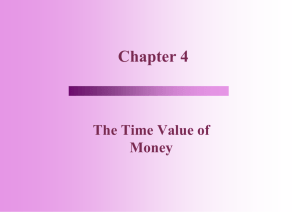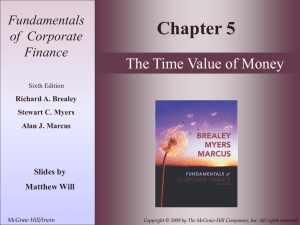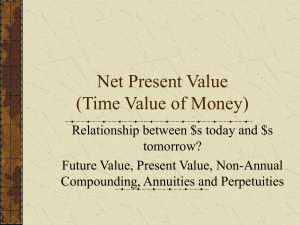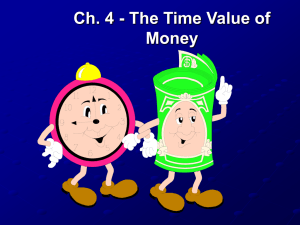Fundamentals of Corporate Finance
advertisement
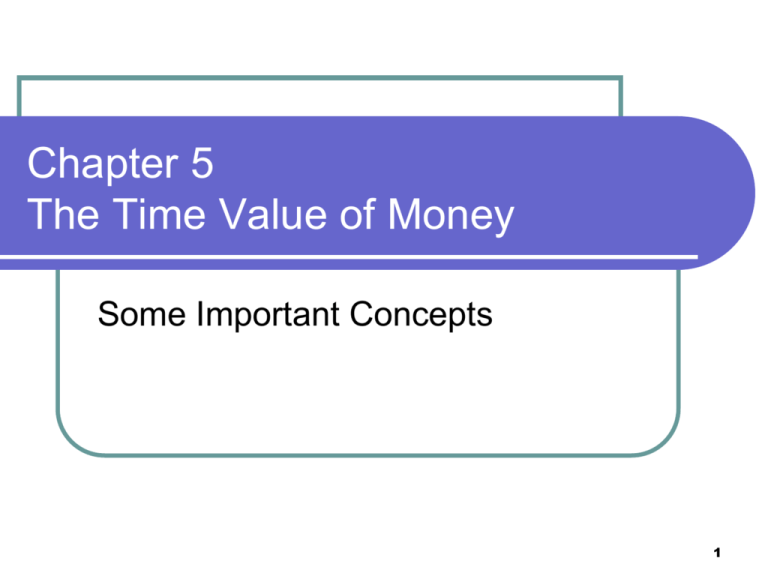
Chapter 5 The Time Value of Money Some Important Concepts 1 Topics Covered Future Values and Compound Interest Present Values Multiple Cash Flows Perpetuities and Annuities Effective Annual Interest Rates. Inflation 2 Future Values Future Value - Amount to which an investment will grow after earning interest. Compound Interest - Interest earned on interest. Simple Interest - Interest earned only on the original investment. 3 Future Values Example - Simple Interest Interest earned at a rate of 6% for five years on a principal balance of $100. Today 0 1 Interest Earned Value 100 6 106 Future Years 2 3 4 5 6 112 6 118 6 124 6 130 Value at the end of Year 5 = $130 4 Future Values Example - Compound Interest Interest earned at a rate of 6% for five years on the previous year’s balance. Today 0 1 Interest Earned Value 100 6 106 Future Years 2 3 4 5 6.36 6.74 7.15 7.57 112.36 119.10 126.25 133.82 Value at the end of Year 5 = $133.82 5 Future Values Future Value of $100 = FV FV $100 (1 r ) t 6 Future Values 7000 0% 6000 5000 10% 4000 15% 3000 2000 1000 30 28 26 24 22 20 18 16 14 12 10 8 6 4 2 0 0 FV of $100 5% Number of Years 7 Future Values Example – Manhattan Island Sale Peter Minuit bought Manhattan Island for $24 in 1626. Was this a good deal? To answer, determine $24 is worth in the year 2006, compounded at 8%. FV $24 (1 .08) $120.57 trillion 380 Financial calculator: n=380, i=8, PV=-24, PMT=0 FV= $120.57 trillion 8 Set up the Texas instrument 2nd, “FORMAT”, set “DEC=9”, ENTER 2nd, “FORMAT”, move “↓” several times, make sure you see “AOS”, not “Chn”. 2nd, “P/Y”, set to “P/Y=1” 2nd, “BGN”, set to “END” P/Y=periods per year, END=cashflow happens end of periods Present Values If the interest rate is at 6 percent per year, how much do we need to invest now in order to produce $106 at the end of the year? Present va lue (PV) future value $106 $100 1.06 1.06 How much would we need to invest now to produce $112.36 after two years? Present va lue (PV) future value $112.36 $100 1.06 2 1.06 2 10 Present Values PV = Future Value after t periods PV: Discounted Cash-Flow (1+ r) t r: Discount Rate (DCF) DF 1 ( 1 r ) t Discount Factor (DF) = PV of $1 Discount Factors can be used to compute the present value of any cash flow. 11 Present Values 120 Interest Rates PV of $100 5% 100 10% 80 15% 60 40 20 0 0 1 2 3 4 5 6 7 8 9 10 11 12 13 14 15 16 17 18 19 20 Number of Years 12 Present Values Example In 2007, Puerto Rico needed to borrow about $2.6 billion for up to 47 years. It did so by selling IOUs, each of which simply promised to pay the holder $1,000 at the end of that time. The market interest rate at the time was 5.15%. How much would you have been prepared to pay for one of these IOUs? 1 PV $1,000 $1,000 .0944 $94.4 47 (1.0515) 13 Present Values Example Kangaroo Autos is offering free credit on a $20,000 car. You pay $8,000 down and then the balance at the end of 2 years. Turtle Motors next door does not offer free credit but will give you $1,000 off the list price. If the interest rate is 10%, which company is offering the better deal? 14 Present Values $12,000 $8,000 PV at Time=0 0 1 2 $8,000 $12,000 Total 1 $9,917.36 (1.10) 2 $17,917.36 15 Present Values Example – Finding the Interest Rate Each Puerto Rico IOU promised to pay holder $1,000 at the end of 47 years. It is sold for $94.4. What is the interest rate? $94.4 (1 r) 47 $1,000 $1,000 (1 r) 10.593 $94.4 (1 r) 10.5931/47 1.0515 47 r 0.0515, or 5.15% Financial calculator: n=47, FV=1,000 PV=-94.4, PMT=0 i=5.15 16 Present Values Example – Double your money Suppose your investment advisor promises to double your money in 8 years. What interest rate is implicitly being promised? FV PV (1 r) t $2 $1 (1 r) 8 r 0.0905, or 9.05% Financial calculator: n=8, FV=2 PV=-1, PMT=0 i=9.05 17 Present Value of Multiple Cash Flows Example Your auto dealer gives you the choice to pay $15,500 cash now, or make three payments: $8,000 now and $4,000 at the end of the following two years. If your cost of money is 8%, which do you prefer? Immediatepayment 8,000.00 PV1 4 , 000 (1.08)1 3,703.70 PV2 4 , 000 (1.08) 2 3,429.36 Total PV $15,133.06 18 What is the PV of this uneven cash flow stream? 0 1 2 3 4 100 300 300 -50 10% 90.91 247.93 225.39 -34.15 530.08 = PV Detailed steps (Texas Instrument calculator) To clear historical data: CF, 2nd ,CE/C To get PV: CF , ↓,100 , Enter , ↓,↓ ,300 , Enter, ↓,2, Enter, ↓, 50, +/-,Enter, ↓,NPV,10,Enter, ↓,CPT “NPV=530.0867427” Future Value of Multiple Cash Flows Example You plan to save some amount of money each year. You put $1,200 in the bank now, another $1,400 at the end of the first year, and a third deposit of $1,000 at the end of the second year. If the interest rate is 8% per year, how much will be available to spend at the end of the 3 year? 21 Future Value of Multiple Cash Flows $1,400 $1,200 $1,000 Year 0 1 2 3 FV in year 3 $1,080.00 $1,000 1.08 $1,632.96 $1,400 (1.08) 2 $1,511.65 $1,200 (1.08)3 $4,224.61 22 Perpetuities and Annuities Annuity Equally spaced level stream of cash flows for a limited period of time. Perpetuity A stream of level cash payments that never ends. 23 Perpetuities and Annuities cash payment C PV of Perpertuit y r interest rate 24 Perpetuities and Annuities Example - Perpetuity In order to create an endowment, which pays $100,000 per year, forever, how much money must be set aside today in the rate of interest is 10%? 100,000 PV $1,000,000 0.10 25 Perpetuities and Annuities Example - continued If the first perpetuity payment will not be received until three years from today, how much money needs to be set aside today? , 000 PV 1(1, 000 2 $826, 446 0.10) 26 Perpetuities and Annuities Cash Flow Year 1. Perpetuity A 0 1 $1 2 $1 3 $1 2. Perpetuity B 3. Three-year annuity $1 $1 $1 4 $1 5 $1 6 … $1 … $1 $1 $1 … Present Value 1 r 1 r (1 r ) 3 1 1 r r (1 r ) 3 27 Perpetuities and Annuities 1 1 PV of t - year annuity C r r (1 r )t C = cash payment r = interest rate t = Number of years cash payment is received 28 Perpetuities and Annuities PV Annuity Factor (PVAF) - The present value of $1 a year for each of t years. 1 PVAF 1 r r (1 r )t 29 Perpetuities and Annuities Example – Lottery Suppose you bought lottery tickets and won $295.7 million. This sum was scheduled to be paid in 25 equal annual installments of $11.828 million each. Assuming that the first payment occurred at the end of 1 year, what was the present value of the prize? The interest rate was 5.9 percent. 1 1 PV $11.828 [ ] 0.059 0.059(1.059) 25 PV $152.6 Financial calculator: n=25, i=5.9, PMT=11.828, FV=0, PV=-152.6 30 Perpetuities and Annuities Annuity Due Level stream of cash flows starting immediately. PV of an annuity due (1 r) PV of an annuity 31 Perpetuities and Annuities Example – Lottery (Continued) What is the value of the prize if you receive the first installment of $11.828 million up front and the remaining payments over the following 24 years? 1 1 ] 1.059 25 0.059 0.059(1.059) PV $152.6 1.059 $161.7 PV $11.828 [ 32 Perpetuities and Annuities Future Value of annual payments t 1 1 FV C (1 r ) r r (1 r )t (1 r ) t 1 C r 33 Perpetuities and Annuities Example - Future Value of annual payments You plan to save $4,000 every year for 20 years and then retire. Given a 10% rate of interest, what will be the FV of your retirement account? 1 1 (1 0.10) 20 FV 4,000 0.10 0.10(1 0.10) 20 FV $229,100 Financial calculator: n=20, i=10, PMT=-4,000, PV=0, FV=229,100 34 Effective Annual Interest Rate Effective Annual Interest Rate - Interest rate that is annualized using compound interest. Annual Percentage Rate (APR) - Interest rate that is annualized using simple interest. 35 Effective Annual Interest Rate Example Given a monthly rate of 1%, what is the Effective Annual Rate(EAR)? What is the Annual Percentage Rate (APR)? EAR = (1 + 0.01)12 - 1 = 0.1268 or 12.68% APR = 0.01 x 12 = 0.12 or 12.00% 36 Classifications of interest rates 1. Nominal rate (iNOM) – also called the APR, quoted rate, or stated rate. An annual rate that ignores compounding effects. Periods must also be given, e.g. 8% Quarterly. 2. Periodic rate (iPER) – amount of interest charged each period, e.g. monthly or quarterly. iPER = iNOM / m, where m is the number of compounding periods per year. e.g., m = 12 for monthly compounding. Classifications of interest rates 3. Effective (or equivalent) annual rate (EAR, also called EFF, APY) : the annual rate of interest actually being earned, taking into account compounding. If the interest rate is compounded m times in a year, the effective annual interest rate is m inom 1 1 m Example, EAR for 10% semiannual investment EAR= ( 1 + 0.10 / 2 )2 – 1 = 10.25% An investor would be indifferent between an investment offering a 10.25% annual return, and one offering a 10% return compounded semiannually. EAR on a Financial Calculator Texas Instruments BAII Plus keys: description: [2nd] [ICONV] Opens interest rate conversion menu Sets 2 payments per year [↑] [C/Y=] 2 [ENTER] Sets 10 APR. [↓][NOM=] 10 [ENTER] [↓] [EFF=] [CPT] 10.25 Why is it important to consider effective rates of return? An investment with monthly payments is different from one with quarterly payments. Must use EAR for comparisons. If iNOM=10%, then EAR for different compounding frequency: Annual Quarterly Monthly Daily 10.00% 10.38% 10.47% 10.52% What’s the FV of a 3-year $100 annuity, if the quoted interest rate is 10%, compounded semiannually? 0 1 1 2 3 2 4 5 3 6 5% 100 100 100 Payments occur annually, but compounding occurs every 6 months. Cannot use normal annuity valuation techniques. Method 1: Compound each cash flow 0 1 1 2 3 2 4 5 3 6 5% 100 100 100 110.25 121.55 331.80 FV3 = $100(1.05)4 + $100(1.05)2 + $100 FV3 = $331.80 Method 2: Financial calculator Find the EAR and treat as an annuity. EAR = ( 1 + 0.10 / 2 )2 – 1 = 10.25%. INPUTS OUTPUT 3 10.25 0 -100 N I/YR PV PMT FV 331.80 When is periodic rate used? iPER is often useful if cash flows occur several times in a year. Inflation Inflation - Rate at which prices as a whole are increasing. Nominal Interest Rate - Rate at which money invested grows. Real Interest Rate - Rate at which the purchasing power of an investment increases. 48 Inflation 1+ nominal interest rate 1 real interest rate = 1+inflation rate approximation formula Real int. rate nominal int. rate - inflation rate 49 Inflation Example If the interest rate on one year govt. bonds is 5.0% and the inflation rate is 2.2%, what is the real interest rate? 1 real interest rate = 1 + .050 1 + .022 1 real interest rate = 1.027 real interest rate = .027 or 2.7% Approximat ion = .050 - .022 = .028 or 2.8% 50 Inflation Be consistent in how you handle inflation!! Use nominal interest rates to discount nominal cash flows. Use real interest rates to discount real cash flows. You will get the same results, whether you use nominal or real figures 51 Inflation Example You own a lease that will cost you $8,000 next year, increasing at 3% a year (the forecasted inflation rate) for 3 additional years (4 years total). If discount rates are 10% what is the present value cost of the lease? 52 Inflation Answer – Nominal figures Year 1 2 3 4 Cash Flow 8000 8000x1.03 = 8240 8000x1.03 2 = 8487.20 8000x1.03 3 = 8741.82 PV @ 10% 8000 1.10 7272.73 8240 6809.92 1.102 8487.20 6376.56 1.103 8741.82 5970.78 1.104 $26,429.99 53 Inflation Answer – Real Figures Year 1 2 3 4 8000 1.03 8240 1.032 8487.20 1.033 8741.82 1.034 Cash Flow = 7766.99 = 7766.99 = 7766.99 = 7766.99 PV@6.7961% 7766.99 1.068 7272.73 7766.99 6809.92 1.0682 7766.99 6376.56 1.0683 7766.99 5970.78 1.0684 = $26,429.99 54



